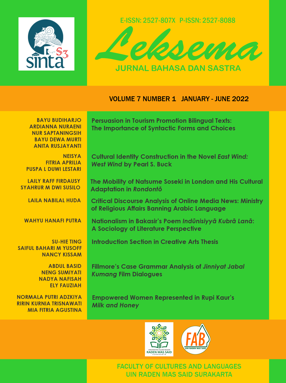CULTURAL IDENTITY CONSTRUCTION IN THE NOVEL 'EAST WIND: WEST WIND' BY PEARL S. BUCK
DOI:
https://doi.org/10.22515/ljbs.v7i1.4110Keywords:
postcolonial, culture, Chinese, American, ambivalenceAbstract
This study analyzed the cultural identity in the novel East Wind: West Wind written by Pearl S. Buck by using postcolonial theory proposed by Bhabha (2007). It aimed to identify the cultural identity, that consists of stereotypes, mimicry, ambivalence, and hybridity, and how it was experienced by the main character in the novel. This study used qualitative method with descriptive approach. The writer collected the data by reading the novel and highlighting the data from the narrations and utterances that were appropriate to the problem of study. The result of this study showed that there are cultural identity construction in the life of Kwei-lan’s, the main character in the novel, which trapped her into identity confusion. Two cultures, namely traditional Chinese and Western culture, cause Kwei-lan’s confusion of her identity. Kwei-lan's attempts to survive from this situation by imitating the modern lifestyle, such as habits, appearances, and parental actions. This cultural shift makes her feel uncanny or being in an unhomely moment where she sticks in the middle between past and present, or between her origin Chinese culture and her new modern Western life.
Downloads
References
Bhabha, Homi K. 2007. The Location of Culture. New York: Routledge
Buck, Pearl S. 1930. East Wind: West Wind. London: Methuen & Co. Ltd
Buck, Pearl S. 2017. Angin Timur: Angin Barat. Yogyakarta: Penerbit Narasi
Dermawan, Rusdian Noor. & Joko Santoso. 2017. “Mimikri dan Resistensi Pribumi Terhadap Kolonialisme dalam Novel Jejak Langkah Karya Pramoedya Ananta Toer: Tinjauan Poskolonial”. Journal of Caraka, 04 (1): 33-58
Dewojati, Cahyaningrum. 2017. “Ambivalensi dan Kuasa Perempuan Terjajah dalam Karina Adinda: Lelakon Komedie Hindia Timoer dalem Tiga Bagian”. Atavisme, 20 (1): 1-13
Fadloly, Maulana Adieb. 2019. “Hibriditas Budaya pada Tokoh Utama dalam Novel Bumi Manusia Karya
Pramoedya Ananta Toer”. (S1 Thesis). Semarang: Universitas Diponegoro
Khoiriyah, Ummul. 2015. “The Influences of Modernity to Kwei-lan and the Husband in Pearl S. Buck’s East Wind: West Wind”. https://jurnalmahasiswa.unesa.ac.id/index.php/ literure-kultura/article/ viewFile/11605/10901
Lestari, Ummu Fatimah Ria. 2016. “Postcolonial Analyzing Gadis Pantai by Pramoedya Ananta Toer based on Homi K. Bhabha Theory”. Medan Makna, 14 (2): 144-153
Lestari, Winda Dwi, Sarwiji Suwandi & Muhammad Rohmadi. 2018. “Subaltern in Novels by Soeratman Sastradihardja: A Post-colonial Literature Study”. Journal of Widyaparwa, 46 (2): 179-188
Loomba, Ania. 2003. Colonialism Postcolonialism. New York: Routledge
Neisya. 2018. “Kerapuhan Identitas Ras Kulit Hitam Afrika dalam Puisi The Little Black Boy Karya William Blake”.Jurnal Ilmiah Bina Bahasa, 11 (02): 11-20
Said, Edward Wadie. 1994. Orientalisme. Bandung: Pustaka
Said, Edward Wadie. 2010. Orientalism. Yogyakarta: Pustaka Pelajar
Sugiyono. 2012. Metode Penelitian Kuantitatif Kualitatif dan R&D. Bandung: Alfabeta.
Taum, Yoseph Yapi. 2017. “Impala-Impala Hindia Imperial Jathee dalam Perspektif Postcolonial Homi K. Bhabha”. Jurnal Ilmiah Kebudayaan Sintesis, 11 (2): 6-15
Downloads
Published
Issue
Section
License
Copyright (c) 2022 Leksema: Jurnal Bahasa dan Sastra

This work is licensed under a Creative Commons Attribution-NonCommercial-ShareAlike 4.0 International License.
The copyright of the received article shall be assigned to the publisher of the journal. The intended copyright includes the right to publish the article in various forms (including reprints). The journal maintains the publishing rights to published articles.
In line with the license, the authors and users (readers or other researchers) are allowed to share and adapt the material only for non-commercial purposes. In addition, the material must be given appropriate credit, provided with a link to the license, and indicated if changes were made. If authors remix, transform or build upon the material, authors must distribute their contributions under the same license as the original.







